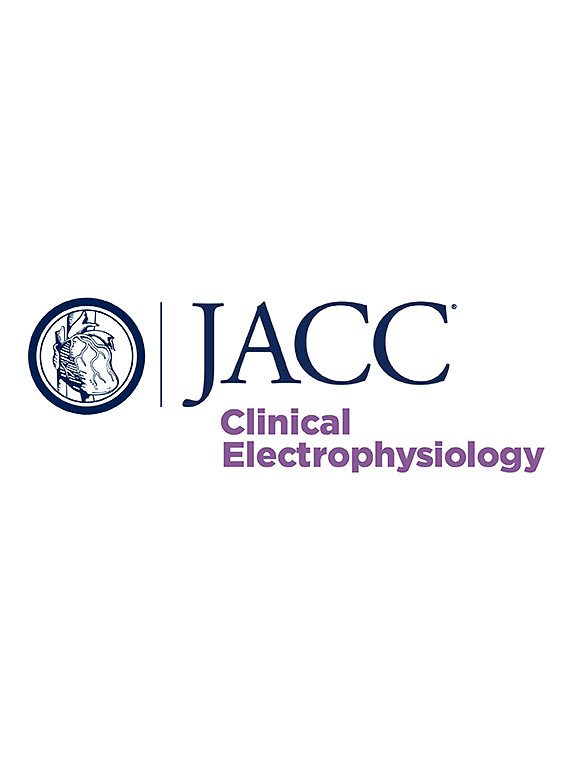瘢痕相关性室性心动过速的心率依赖性起搏图匹配:TR 融合 "现象的影响。
IF 8
1区 医学
Q1 CARDIAC & CARDIOVASCULAR SYSTEMS
引用次数: 0
摘要
背景尚未系统评估不同起搏率的起搏图(PM)对瘢痕相关室速(VT)患者 QRS 形态和 PM 评分匹配的影响。目的在本研究中,我们试图评估不同起搏率下 PM 评分匹配的可变性。方法在 VT 消融的基底映射期间,分别在周期长度(CL)为 600 ms、500 ms、400 ms、300 ms 和 VT CL 时进行 PM。对整个 QRS、QRS 的前半部分(H1)和 QRS 的后半部分(H2)的 PM 评分进行了比较,以检查前 T 波叠加到起搏 QRS 复极(TR 融合)的影响。结果系统分析了 40 名接受瘢痕相关 VT 消融术患者的 269 个 PM。PM 评分的改善率更接近 VT,特定部位最低和最高 PM 评分之间的中位差异为 6%(Q1-Q3:4%-10%;范围:0-33%)。在较快节奏的 CL 中观察到 QRS 起始点更加模糊,这与之前的 T 波叠加到 QRS 起始点有关,QRS 复极的 H1 有显著差异,但 H2 没有。结论:起搏频率可显著改变形态学评分匹配,最接近 VT CL 时可观察到最佳匹配。QRS 波群形态的起始受到前 T 波叠加的影响,导致 TR 融合现象未得到充分认识,这可能会混淆基于初始 QRS 斜率和矢量的心外膜心电图标准。本文章由计算机程序翻译,如有差异,请以英文原文为准。
Rate-Dependent Pacemap Matching in Scar-Related Ventricular Tachycardia
Background
The impact of varying rates of pacemapping (PM) rates on QRS morphology and PM score matching in patients with scar-related ventricular tachycardia (VT) has not been systematically assessed.
Objectives
In this study, the authors sought to assess the variability in PM score matching at different pacing rates.
Methods
During substrate mapping for VT ablation, PM was performed at cycle lengths (CLs) of 600 ms, 500 ms, 400 ms, 300 ms, and VT CL. PM scores were compared for the entire QRS, the first half (H1) of QRS, and the second half (H2) of QRS to examine the influence of the preceding T-wave superimposed into the onset of paced QRS complex (TR fusion).
Results
A total of 269 PMs in 40 patients undergoing scar-related VT ablation were systematically analyzed. The PM score improved at rates closer to VT with a median difference of 6% (Q1-Q3: 4%-10%; range: 0%-33%) between the lowest and the highest PM scores at a given site. Greater slurring of the QRS onset was observed at faster-paced CL, corresponding to a superimposition of the preceding T-wave into QRS onset, with significant differences in H1 but not H2 of the QRS complex. At faster PM rates, 32% of overall sites developed pseudo delta wave and 69% of endocardial pacing sites fulfilled epicardial criteria.
Conclusions
The rate of pacemapping can significantly alter morphologic score matching, with the most optimal match observed closest to VT CL. The onset of QRS complex morphology is influenced by superimposition of the preceding T-wave at faster rates, resulting in an underrecognized TR fusion phenomenon that may confound epicardial electrocardiographic criteria predicated upon the initial QRS slope and vector.
求助全文
通过发布文献求助,成功后即可免费获取论文全文。
去求助
来源期刊

JACC. Clinical electrophysiology
CARDIAC & CARDIOVASCULAR SYSTEMS-
CiteScore
10.30
自引率
5.70%
发文量
250
期刊介绍:
JACC: Clinical Electrophysiology is one of a family of specialist journals launched by the renowned Journal of the American College of Cardiology (JACC). It encompasses all aspects of the epidemiology, pathogenesis, diagnosis and treatment of cardiac arrhythmias. Submissions of original research and state-of-the-art reviews from cardiology, cardiovascular surgery, neurology, outcomes research, and related fields are encouraged. Experimental and preclinical work that directly relates to diagnostic or therapeutic interventions are also encouraged. In general, case reports will not be considered for publication.
 求助内容:
求助内容: 应助结果提醒方式:
应助结果提醒方式:


